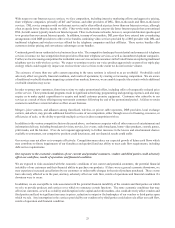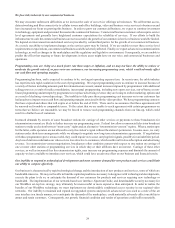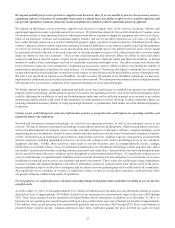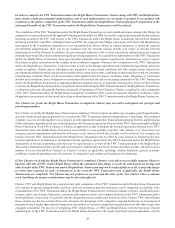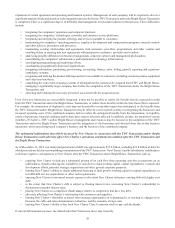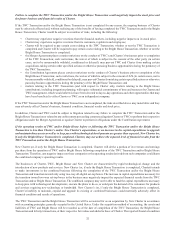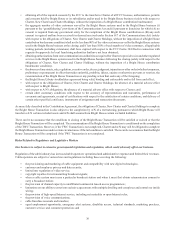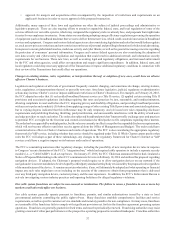Charter 2015 Annual Report Download - page 44
Download and view the complete annual report
Please find page 44 of the 2015 Charter annual report below. You can navigate through the pages in the report by either clicking on the pages listed below, or by using the keyword search tool below to find specific information within the annual report.29
expansion of certain operations and operating and financial systems. Management of each company will be required to devote a
significant amount of time and attention to the integration process before the TWC Transaction and/or the Bright House Transaction
is completed. There is a significant degree of difficulty and management involvement inherent in that process. These difficulties
include:
• integrating the companies’ operations and corporate functions;
• integrating the companies’ technologies, networks and customer service platforms;
• integrating and unifying the product offerings and services available to customers;
• harmonizing the companies’ operating practices, employee development and compensation programs, internal controls
and other policies, procedures and processes;
• maintaining existing relationships and agreements with customers, providers, programmers and other vendors and
avoiding delays in entering into new agreements with prospective customers, providers and vendors;
• addressing possible differences in business backgrounds, corporate cultures and management philosophies;
• consolidating the companies’ administrative and information technology infrastructure;
• coordinating programming and marketing efforts;
• coordinating geographically dispersed organizations;
• integrating information, purchasing, provisioning, accounting, finance, sales, billing, payroll, reporting and regulatory
compliance systems;
• integrating and unifying the product offerings and services available to customers, including customer premise equipment
and video user interfaces;
• completing the conversion of analog systems to all-digital for the systems to be acquired from TWC and Bright House;
• managing a significantly larger company than before the completion of the TWC Transaction and/or the Bright House
Transaction; and
• attracting and retaining the necessary personnel associated with the acquired assets.
Even if the new businesses are successfully integrated, it may not be possible to realize the benefits that are expected to result
from the TWC Transaction and/or the Bright House Transaction, or realize these benefits within the time frame that is expected.
For example, the elimination of duplicative costs may not be possible or may take longer than anticipated, or the benefits from
the TWC Transaction and/or Bright House Transaction may be offset by costs incurred or delays in integrating the businesses and
increased operating costs. If the combined company fails to realize the anticipated benefits from the transactions, its liquidity,
results of operations, financial condition and/or share price may be adversely affected. In addition, at times, the attention of certain
members of Charter’s, TWC’s and/or Bright House’s management and resources may be focused on the completion of the TWC
Transaction and/or the Bright House Transaction and the integration of the businesses and diverted from day-to-day business
operations, which may disrupt each company’s business and the business of the combined company.
The substantial indebtedness that will be incurred by New Charter in connection with the TWC Transaction and/or Bright
House Transaction could adversely affect New Charter’s operations and financial condition after the TWC Transaction and
the Bright House Transaction.
As of December 31, 2015, our total principal amount of debt was approximately $35.9 billion, including $21.8 billion of debt for
which proceeds are held in escrow pending consummation of the TWC Transaction. New Charter’s and its subsidiaries’ indebtedness
could have negative consequences to New Charter after the TWC Transaction and/or Bright House Transaction, such as:
• requiring New Charter to dedicate a substantial portion of its cash flow from operating activities to payments on its
indebtedness, thereby reducing the availability of cash flow to fund working capital, capital expenditures, research and
development efforts, potential strategic acquisitions and other general corporate purposes;
• limiting New Charter’s ability to obtain additional financing to fund growth, working capital or capital expenditures, or
to fulfill debt service requirements or other cash requirements;
• exposing New Charter to increased interest expense to the extent New Charter refinances existing debt with higher cost
debt;
• to the extent that New Charter’s debt is subject to floating interest rates, increasing New Charter’s vulnerability to
fluctuations in market interest rates;
• placing New Charter at a competitive disadvantage relative to competitors that have less debt;
• adversely affecting New Charter’s relationship with customers and suppliers;
• limiting New Charter’s flexibility to pursue other strategic opportunities or in planning for, or reacting to, changes in its
business, the cable and telecommunications industries, and the economy at large; and
• limiting New Charter’s ability to buy back New Charter Class A common stock or pay cash dividends.
If current debt amounts increase, the related risks that Charter now faces may intensify.






